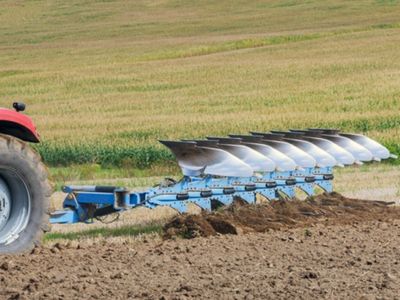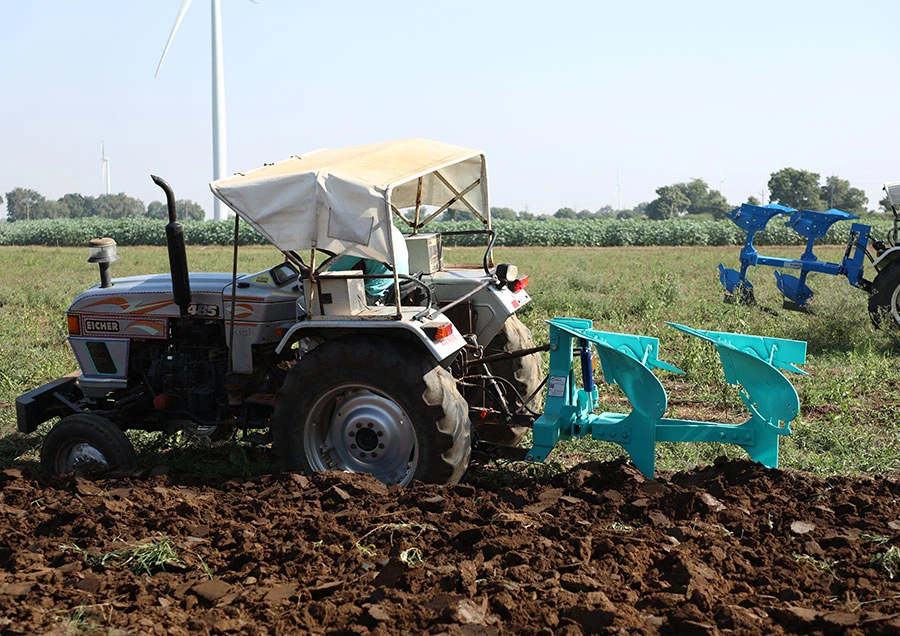Chat With Us
+91 99253 37969Unveiling the Importance of Ploughing in Modern Farming

Ploughing also known as tilling, is like the groundwork of modern farming. It's all about getting the soil ready for planting crops. But besides this, it has other benefits such as keeping weeds in check and ensuring our crops grow healthy and strong.
In this guide, let’s dig deep into why ploughing is so important for today's farmers. We'll look at how it helps the soil. And, why it's great for keeping weeds away, and how it keeps the nutrients for crops to thrive. So, let's start with understanding ploughing!
Understanding Ploughing

Ploughing is getting the soil ready for planting crops. Back in the day, farmers used animals to pull ploughs through the fields. But now we've got machines like tractors to do the job.
The goal is simple break the hard soil, bury old plant stuff, and make the ground nice. All while making it soft for planting seeds. Whether it's old-school or modern methods, the idea is to give crops the best start possible in the soil.
Importance of Ploughing
1. Soil Preparation
Ploughing is like giving the soil a makeover before planting crops. When we plough, we're turning the soil upside down to loosen it up. This helps air, water, and nutrients get into the soil more easily. Thereby, helping plants to grow strong and healthy.
Plus, it also hides old plant stuff from past harvests deep in the soil. That's good because it stops pests and diseases from hanging around. Hence, gives the soil some extra nutrients to help new plants grow. So, think of the process as giving the soil a fresh start for the next crop.
2. Weed Control
Tilling isn't just about getting the soil ready for planting; it's also great for dealing with weeds. When we plough, we're not only turning the soil but also getting rid of weeds by burying them underground. This stops them from growing and stealing nutrients and sunlight from our crops.
Plus, when we bury weed seeds deep in the soil, they're less likely to sprout. However, sometimes we might need to use other methods like changing the crops we plant or even using special weed-killing chemicals along with ploughing to keep those pesky weeds under control.
3. Pest Management
Ploughing means not just turning the soil and getting rid of weeds; It also helps in pest management by exposing insects, their eggs and larvae to the surface, exposing them to natural predators and sunlight.
Also, ploughing messes up the living conditions of some pests and diseases, like bugs that hibernate in the soil or germs. This makes it tougher for them to survive and multiply, which helps to grow our crops naturally.
4. Nutrient Cycling
When we plough, we're helping to recycle nutrients in the soil. You see, when crops grow, they use up a lot of nutrients from the soil. Ploughing mixes leftover parts of old plants and other natural stuff into the soil. This mixture is like a buffet for tiny living things in the soil called microorganisms.
They munch on this stuff and turn it into nutrients that plants use to grow. So, by tilling, we're giving our soil a nutrient boost, which means our crops grow healthier without needing as much artificial fertilizer. It's like giving our soil and crops a natural vitamin pill.
5. Seedbed Preparation
With ploughing, we create a soft, crumbly surface that's perfect for seeds to settle into. It helps in aerating the soil, improving drainage, and incorporating organic matter for enhanced fertility. This makes it easier for them to sprout and grow strong roots.
Improved soil structure from ploughing promotes better water infiltration, ensuring adequate moisture for seed germination. Ultimately, ploughing creates an optimal environment for successful planting and crop establishment, setting the foundation for healthy growth and higher yields.
6. Soil Conservation
Ploughing is like a shield for the soil, protecting it from erosion and helping it hold onto water better. When we plough, we loosen up the soil and create little channels where rainwater sinks in instead of running off. This keeps the soil in place and prevents it from washing away during heavy rains.
Also, ploughing helps to loosen up soil that's been compacted by tractors and people walking on it. When soil gets too compacted, it's hard for plants to grow roots and get the nutrients they need. So, by giving the soil a little breathing room, it helps plants thrive and keeps the land healthy for future generations.
Conclusion
By understanding the importance of ploughing and implementing best practices, farmers optimize soil health, crop productivity, and environmental sustainability for generations to come. Hydraulic reversible disc ploughs and hydraulic reversible MB ploughs have revolutionized the tilling process, offering farmers efficient and effective implementations to optimize their agricultural operations and maximize crop productivity.
By recognizing the importance of ploughing and adopting modern ploughing techniques and equipment, farmers ensure sustainable and profitable farming practices.
Also Read: Comprehensive Differentiation Between Ploughing and Harrowing





